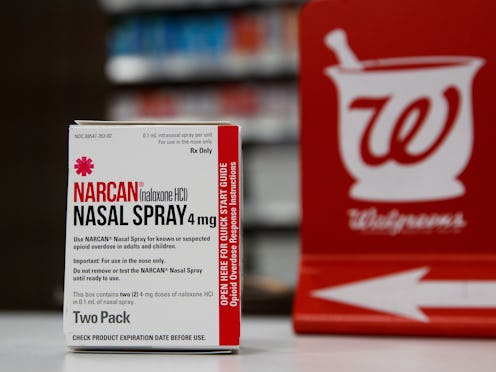Life
7 Things Everyone Should Know About Narcan, The Opioid Overdose Reversal Drug

In the United States, 115 people are killed by opioid overdoses every single day, according to analysis from the CDC. These deaths could be prevented with access to Narcan, the brand name for naloxone, an opioid overdose reversal drug that's been on the market since 1971, but since 2016 has been available as a nasal spray that can be used by anyone to reverse a suspected overdose. Though the person suspected of overdosing will still need emergency medical care, Narcan can be a life-saving drug for people at risk of overdosing on any kind of opioid, including prescription drugs or heroin. And the best part is that, in many parts of the country, you can get it from your local pharmacy, without a prescription.
"If your loved one is using opioids, you should have Narcan on hand," says Dr. Sal Raichbach, Chief of Clinical Compliance at Ambrosia Treatment Centers. "There is no reason not to have it." Since 2017, it's been stocked at every Walgreens in the country, without need for a prescription, and CVS also offers it without a prescription in 43 states. Depending on your insurance, you might pay a small copay, but it retails for between $40 and $125. It can also be found at community health organizations. The medication's website will show you where to get Narcan based on your zip code.
The theory behind Narcan's easy availability to the public is based on a simple fact: in the majority of overdose cases, the first people on the scene aren't emergency paramedics — they're laypeople, friends or family of the person overdosing, according to the CDC. And if someone is suspected of overdosing, it's imperative to get them help ASAP, before the opioid depresses their respiration and heart rate to the point where their body begins to shut down. Narcan works by "binding" to opioid receptors, which are found throughout the body, and reversing the effects of an opioid overdose, Dr. Raichbach tells Bustle. Administering naloxone "immediately reverses the effects of opioid drugs, restoring normal respiration," says the National Institute For Drug Abuse.
"Narcan is pre-dosed," Dr. Raichbach says, "so anyone who can follow simple instructions can save a life." It's can be necessary to give people who've overdosed a second dose of Narcan before emergency help arrives. The medication can be either sprayed up the nose of somebody who's lying down, or administered via a muscular injection into the arm, leg or buttocks. (The injectable form of naloxone is sold as Evzio). Narcan's website has a diagram of how to administer the nasal spray, as well as signs of an opioid overdose to watch out for. These signs can include excessive sleepiness or non-responsiveness, shallow breathing, or extremely small pupils.
Narcan is "extremely safe," Dr. Raichbach explains to Bustle. "It can't get you high, it’s non-addictive, and you can't overdose on it." However, a dose can come with unpleasant side effects. Narcan's website notes that opioid withdrawal symptoms, such as muscle aches, abdominal cramping, nausea, vomiting, or diarrhea, can begin after administering the drug, since Narcan works to block the body's opioid receptors. Additionally, blood pressure changes, irregular heartbeat, fluid in the lungs, or seizures can result. Narcan should always be followed up with emergency medical care, regardless of the presence of side effects.
Though Naloxone is a hugely effective drug, and experts believe it's been responsible for saving 26,000 people in the U.S. alone since 1996, it isn't without its risks, aside from the side effects. Opioid users experience such acute withdrawal after a Narcan dose — which only binds onto the receptors for about 60 to 90 minutes — that they can be prompted to use again as soon as the drug wears off, an investigation by The Daily Beast found in 2016. (Another important reason for users to seek out further medical care, as healthcare providers can work to mitigate the symptoms of withdrawal.)
Narcan is part of the arsenal being used to battle America's opioid epidemic; various school districts in America have included Narcan as part of their emergency medical resources, and an experiment in Massachusetts in 2016 distributed Narcan to people who needed it and found that overdoses from opiates dropped by 11 percent. And though some critics claim that Narcan's availability will encourage people with substance use disorder to use opioids recklessly, medical professionals note that having access to it is a whole lot better than not: A study of Narcan use in 2017 found that naloxone reversed 93 percent of the overdoses it treated, and a year after a dose of the anti-overdose drug, 84.3 percent of the people who'd had it were still alive.
"Many critics complain that because it doesn’t treat the underlying causes of addiction, it isn't effective," Dr. Raichbach tells Bustle. However, "Naloxone was never meant to treat or cure addiction; it simply buys that person time until you can get them to the hospital. During an overdose, those seconds are crucial." And, Dr. Raichbach suggests, saving someone's life with naloxone can help spur them to get the help they need.
Narcan can save a neighbor, a friend, or a stranger, and anyone can use it. As Dr. Raichbach says, there is no reason not to keep Narcan on hand, whether someone in your life lives with substance use disorder or not.
If you or someone you know is seeking help for substance use, call the SAMHSA National Helpline at 1-800-662-HELP(4357).